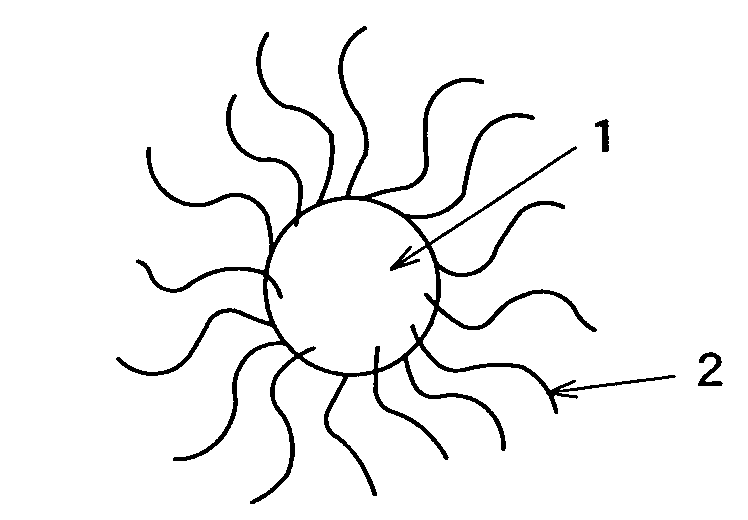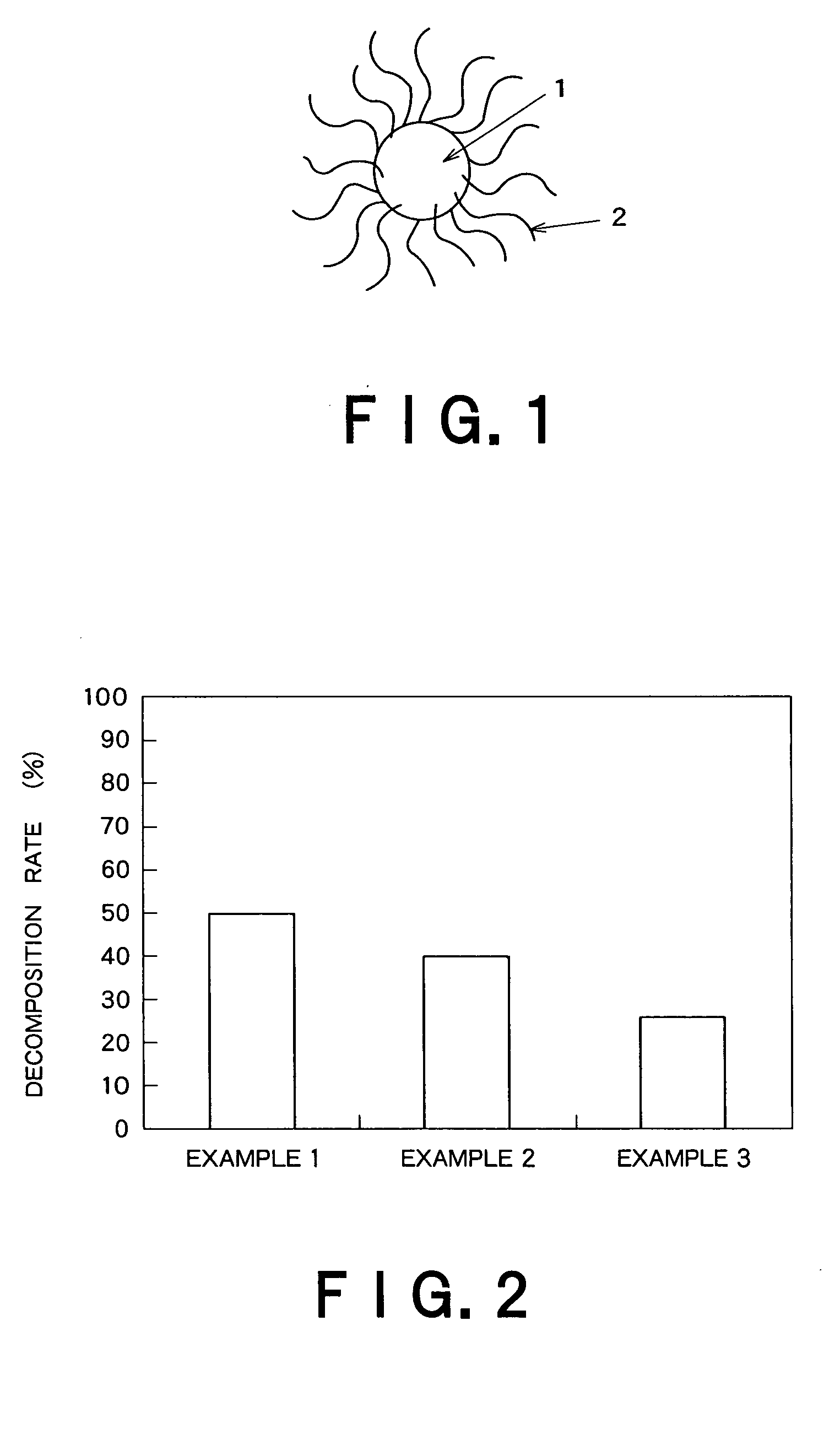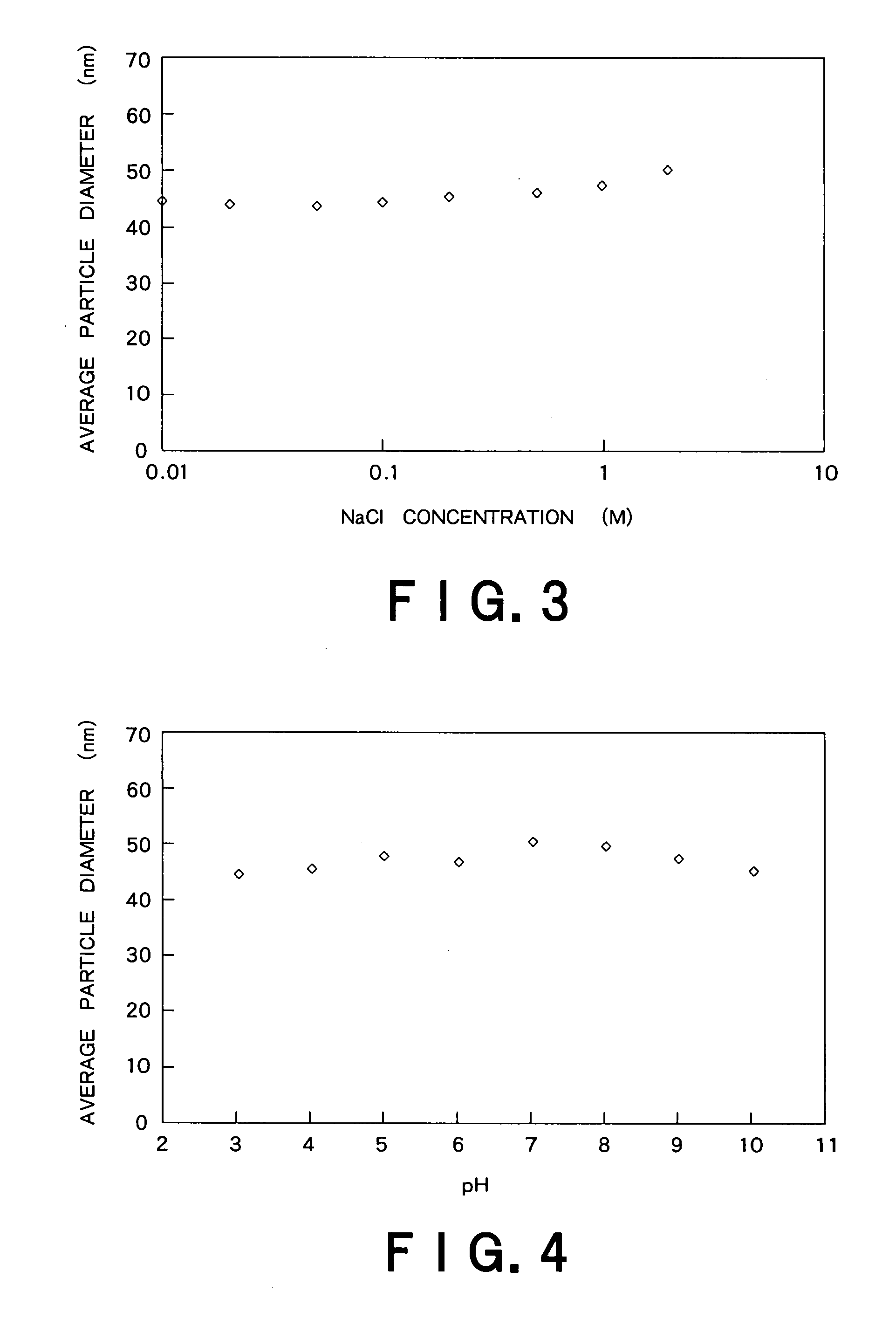Titanium Oxide Composite Particles, Dispersion Liquid Thereof, and Process for Producing Them
a technology of titanium oxide and composite particles, which is applied in the field of titanium oxide composite particles, can solve the problems of lowering the catalytic activity of titanium oxide, difficult to homogeneous dispersing of titanium oxide particles, and inapplicable techniques, etc., and achieves the effect of improving retentivity
- Summary
- Abstract
- Description
- Claims
- Application Information
AI Technical Summary
Benefits of technology
Problems solved by technology
Method used
Image
Examples
example 1
Introduction of Maleic Acid-Type Polyethylene Glycol into Titanium Oxide Particles
[0096]Titanium tetraisopropoxide (3.6 g) was mixed with 3.6 g of isopropanol, and the mixture was added dropwise to 60 ml of ultrapure water under ice cooling for hydrolysis. After the dropwise addition, the mixture was stirred at room temperature for 30 min. After the stirring, 1 ml of 12 N nitric acid was added dropwise thereto, and the mixture was stirred at 80° C. for 8 hr for peptization. After the completion of the peptization, the mixture was filtered through a 0.45-μm filter and was subjected to solution exchange with a desalination column (PD-10, manufactured by Amersham Bioscience) to prepare an acidic titanium oxide sol having a solid content of 1%. This titanium oxide sol was placed in a 100-ml vial bottle and was ultrasonicated at 200 kHz for 30 min in an ultrasonic generator MIDSONIC 200 (manufactured by KAIJO Corporation). The average dispersed particle diameter after the ultrasonication...
example 2
Introduction of Polyethylene Glycol into Polyacrylic Acid-Bound Titanium Oxide Nanoparticles
[0098]Titanium tetraisopropoxide (3.6 g) was mixed with 3.6 g of isopropanol, and the mixture was added dropwise to 60 ml of ultrapure water under ice cooling for hydrolysis. After the dropwise addition, the mixture was stirred at room temperature for 30 min. After the stirring, 1 ml of 12 N nitric acid was added dropwise thereto, and the mixture was stirred at 80° C. for 8 hr for peptization. After the completion of the peptization, the mixture was filtered through a 0.45-μm filter and was subjected to solution exchange with a desalination column (PD-10, manufactured by Amersham Bioscience) to prepare an acidic titanium oxide sol having a solid content of 1%. This titanium oxide sol was placed in a 100-ml vial bottle and was ultrasonicated at 200 kHz for 30 min. The average dispersed particle diameter after the ultrasonication was measured by a dynamic light scattering method. This measureme...
example 3
Introduction of Polyethylene Glycol into Polyethyleneimine-Bound Titanium Oxide Nanoparticles
[0101]Titanium tetraisopropoxide (3.6 g) was mixed with 3.6 g of isopropanol, and the mixture was added dropwise to 60 ml of ultrapure water under ice cooling for hydrolysis. After the dropwise addition, the mixture was stirred at room temperature for 30 min. After the stirring, 1 ml of 12 N nitric acid was added dropwise thereto, and the mixture was stirred at 80° C. for 8 hr for peptization. After the completion of the peptization, the mixture was filtered through a 0.45-μm filter and was subjected to solution exchange with a desalination column (PD-10, manufactured by Amersham Pharmacia Bioscience) to prepare an acidic titanium oxide sol having a solid content of 1%. This titanium oxide sol was placed in a 100-ml vial bottle and was ultrasonicated at 200 kHz for 30 min. The average dispersed particle diameter after the ultrasonication was measured by a dynamic light scattering method. Thi...
PUM
| Property | Measurement | Unit |
|---|---|---|
| zeta potential | aaaaa | aaaaa |
| diameter | aaaaa | aaaaa |
| pH | aaaaa | aaaaa |
Abstract
Description
Claims
Application Information
 Login to View More
Login to View More - R&D
- Intellectual Property
- Life Sciences
- Materials
- Tech Scout
- Unparalleled Data Quality
- Higher Quality Content
- 60% Fewer Hallucinations
Browse by: Latest US Patents, China's latest patents, Technical Efficacy Thesaurus, Application Domain, Technology Topic, Popular Technical Reports.
© 2025 PatSnap. All rights reserved.Legal|Privacy policy|Modern Slavery Act Transparency Statement|Sitemap|About US| Contact US: help@patsnap.com



